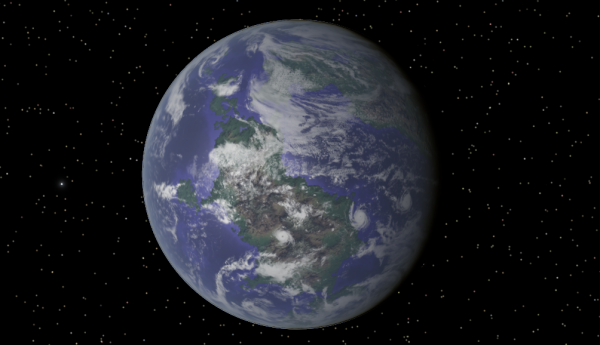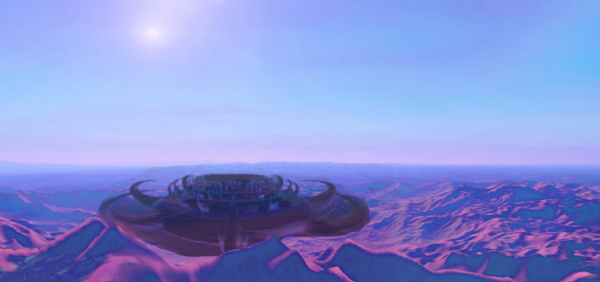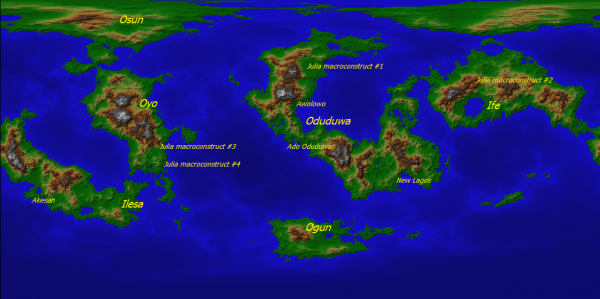BY LETTER
Yoruba
Galactography > Sephirotic Empires > Fomalhaut Acquisition Society
Galactography > Regions of Space > Middle Regions/Hinter-regions
Galactography > Systems and Worlds > Systems & Worlds Y - Z
Galactography > Regions of Space > Middle Regions/Hinter-regions
Galactography > Systems and Worlds > Systems & Worlds Y - Z
Terraformed world with relics of an earlier colonisation by ahuman AI |
 Image from Steve Bowers |
Star: HD 216008
Type: G2v
Luminosity: 1.18 x Sol
Distance from Sol: 167 ly
Constellation: Grus
Planet Edo: Hot Neptune - diameter 56066 km - semimajor axis 0.102 AU
Planet Ibo: Azurojovian - diameter76888 km - semimajor axis 0.319 AU
Planet Yoruba: lifeless gaian - 61% ocean cover- diameter 10314km - mass 0.51x Earth - surface gravity - 0.78 gees semimajor axis 1.06 AU
The HD 216008 system was first reached in approximately 1800 AT by a rogue ahuman AI. This entity (which does not seem to have assumed a name at any point, but is sometimes known as Julia because of the fractal nature of its constructs) appears to have left the Solar System before the Great Expulsion and was part of the short-lived Inner Diamond belt culture until the emergence of the First Federation. Like many Diamond Belt entities Julia left the Inner Sphere rather than be overwhelmed by Federation culture, and for five centuries this entity exploited the resources in this empty system by creating increasingly elaborate computronium structures on the moons of Ibo and on the lifeless surface of the small terrestrial planet Yoruba.
 Image from Steve Bowers | |
| The strange, dark, semitransparent computronium constructions left behind by the entity known as Julia still contain useful intelligent agents, which the Fomacists have acquired for their own use and profit | |
In 2307 an Expansion Age colony ship arrived in the system, carrying nearbaseline humans from Luna, Mars and the asteroid belt, many of whom claimed West African ancestry. As they approached, they observed the departure of the ahuman entity in a spacecraft of unusual design, leaving most of the computronium fractal structures inert but intact. During the next seven hundred years they terraformed the terrestrial world, now called Yoruba, but the enigmatic ahuman structures yielded few secrets.
During this period the relatively minor empire known as the Fomalhaut Acquisition Society became increasingly influential in this region of space, and the Curators and Acquistors were particularly interested in the fractal constructs dotting the planetscape. Some were located in inhospitable regions, but others were located in convenient places for habitation, and since they were constructed of resilient diamondoid they could be used as ready-made foundations for colony towns and cities. in 3055 a FAS acquisitor/trader mission obtained a decryption key from the still-active diamond belt system of JD 778-0919-1 which could unlock the mysteries inside the computronium structures; for a thousand years the Curators of the FAS explored the strange datascapes contained within; during this time Yoruba formally became a member of the relatively modest Fomalhaut empire.
Piecing together the information obtained, the Curators determined that the structures had been built to support a complex of semi-sentient agents, entities with independent mental identities which could be instantiated and copied on demand, but which were all subtly and randomly different. By interacting with each other these entities could consider, debate and formulate new concepts and ideas. Each agent was generated with a slightly or radically different viewpoint and set of prejudices, but was capable of altering or adjusting its attitudes over time as a result of debate with other agents. At length a hypothesis emerged among the Curators that the departed ahuman entity which they knew as Julia had created these computronium complexes as a result of isolation, possibly even loneliness; by creating innumerable independent sub-entities each capable of debate, Julia had found companionship of sorts.
These intelligent agents were found to be both user-friendly and congenial, but argumentative; the FAS classified them as Randomly-generated Partisan Agents, and they began to market them as both companions and decision-reaching assistants. In a small habitat or colony, a spacecraft on a long journey or an intelligent super-object looking for new opinions, these Partisan agents can contribute considerably to the diversity of the social, political and philosophical landscape.
 Image from Steve Bowers | |
| There are more than two thousand fractal constructs on Yoruba, four of which are larger than 500 km2 | |
In the current era most of the Julian fractal constructs can be found at the centre of much larger communities, cities that have grown up around, over and even beneath these complex structures. Citizens of these communities are familiar with the strange, dark forms of the processor fractals, and are educated from an early age to be wary of their razor-sharp edges, but unfortunate accidents still occur with some regularity.
Related Articles
Appears in Topics
Development Notes
Text by Steve Bowers
Initially published on 17 April 2014.
Initially published on 17 April 2014.






